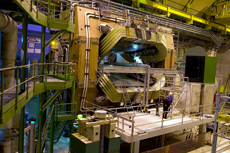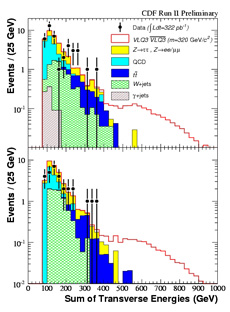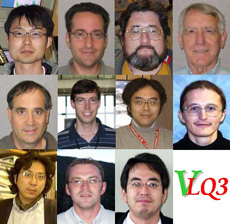|
Thurs., July 5
1:00 p.m.
ILC ALCPG Physics and Detector Seminar - WH-10NW, West Wing
Speaker: T. Rizzo, Stanford Linear Accelerator Center
Title: LHC-1 =ILC Project Update
THERE WILL BE NO THEORETICAL PHYSICS SEMINAR THIS WEEK
3:30 p.m.
DIRECTOR'S COFFEE BREAK - 2nd Flr X-Over
THERE WILL BE NO ACCELERATOR PHYSICS AND TECHNOLOGY
SEMINAR TODAY
Fri., July 6
3:30 p.m.
DIRECTOR'S COFFEE BREAK - 2nd Flr X-Over
4:00 p.m.
Joint Experimental-Theoretical Physics Seminar - One West
Speaker: S. Dodelson, Fermilab
Title: Neutrinos and the Universe - Cosmology
(as part of the Neutrino Physics Summer School)
Click here for NALCAL,
a weekly calendar with links to additional information. |
Thursday, July 5
-Tomato florentine
-*Grilled chicken cordon bleu sandwich
-Chimichangas
-Smart Cuisine: chicken marsala
-Smoked turkey melt
-Assorted sliced pizza
-SW chicken salad w/roasted corn salsa
*Carb Restricted Alternative
Wilson Hall Cafe Menu |
|
Thursday, July 5
Dinner
Closed
Wednesday, July 11
Lunch
- Charcuterie salad
- Peach and strawberry shortcakes
Chez Leon Menu
Call x4598 to make your reservation. |
|
|
Beauty and B mesons at LHCb detector

The LHCb detector's magnet and surrounding iron yoke.
Each morning when you look in the bathroom mirror you expect to see an identical reflection of yourself. However, imagine that one morning your mirror-twin didn't pick up the toothbrush in the same way that you did.
For years, physicists believed that matter particles and their antimatter twins should behave identically, as if they were mirror images. Then, in 1964, scientists observed a certain neutral kaon decay process that defied those predictions. The phenomenon, called "CP violation," has since been an area of intense study, particularly because it may provide insight into the mysterious lack of antimatter in the universe.
Now, an international team of scientists at CERN plans to explore CP violation in a new experiment called "Large Hadron Collider beauty," or LHCb for short.
LHCb spokesperson Tatsuya Nakada said, "We [the collaboration scientists] hope to discover physics beyond the Standard Model by studying rare phenomena such as CP violation and rare decays of bottom, down, and strange quark mesons."
Current theory holds that matter and antimatter existed in equal amounts just after the Big Bang and therefore should have eventually annihilated into a sea of photons. The preponderance of matter in the universe today clearly demonstrates that this didn't happen, so something must have tipped the balance. While current particle theory doesn't completely account for the disparity, LHCb may be able to provide more insight.
The 21-meter-long LHCb detector is constructed in layers and allows for the study of particles emitted in the forward direction. By analyzing the data collected, LHCb physicists will measure important CP violation properties and perhaps even discover new subatomic mechanisms for the matter/antimatter imbalance, such as those proposed by supersymmetric theories.
Nakada has high expectations for the experiment. "While the Standard Model cannot generate enough asymmetry between the matter and antimatter to account for the amount of matter in the universe, LHCb may detect new physics that could explain the discrepancy," he said.
-- J. Bryan Lowder
|
Summer of learning: what's with all these grid schools?

Grid summer schools are a catalyst for the creation of long-lasting international and inter-disciplinary networks. This image was taken at the Biomed GRID School, held 14-19 May 2007, in Varenna, Italy.
Image courtesy of David Fergusson
It's that time of year again: the snow melts, the skies turn blue, and grid summer schools appear across the planet.
David Fergusson is something of an old hand when it comes to grid education: he has organised and attended numerous training events, workshops and summer schools; managed the NA3 Training Activity during EGEE I; and is currently the deputy director for Training Outreach and Education at the National e-Science Centre, Edinburgh, UK, as well as the Manager of ICEAGE, a project dedicated to advanced grid education events. Fergusson found time between summer schools to chat with EGEE's Alison McCall.
Alison McCall: Why hold grid summer schools?
David Fergusson: Grid summer schools bring together experts from a wide variety of technologies and sciences, people who could not otherwise get together. For instance, a single university could not provide experts from all the middleware technologies, but we have such experts teaching at the summer schools. For example, at past schools we've had Ian Foster, Satoshi Matsuoka, Miron Livny, Erwin Laure and Malcolm Atkinson, all under one roof.
Read More
-- Alison McCall, EGEE
|
Pierre Auger Press Release
July 3, 2007
Pierre Auger Observatory shares cosmic-ray data with public, students
MALARGÜE, Argentina -- Scientists of the Pierre Auger Collaboration will begin today (July 3) the public release of one percent of the cosmic-ray events recorded by the Pierre Auger Observatory in Argentina. New cosmic-ray data-about 70 events per day-will be posted on a daily basis. The data and their visualizations are available at www.auger.org and www.auger.org.ar.
The international Pierre Auger Collaboration, which includes scientists from 17 countries, explores the origins of extremely rare ultra-high-energy cosmic rays -- particles from space that hit Earth, some with energies 100 million times higher than those made by the world's highest-energy particle accelerator, the Tevatron at Fermilab. These are the highest-energy particles ever recorded in nature. When such a particle hits the atmosphere it creates an air shower that can contain 200 billion particles by the time it reaches the ground.
The one-percent release is part of the worldwide Pierre Auger education and outreach program. It will allow teachers to expose students to real scientific data and the breathtaking processes that take place in the cosmos, hurling charged particles toward Earth. The two Web sites provide the data both as graphical displays and in tabular form. For each cosmic-ray air shower, the Web sites show the energy and direction of the incoming cosmic-ray particle. The public data provides information on cosmic-rays with extremely high energy, up to 5 x 10^19 electron volts (eV).
Read more
|
|
|
Leptons and quarks:
Are they related?

A hypothetical leptoquark signal (red line) is shown compared to Standard Model background processes (colored regions) and the actual CDF data for two different decay modes. Further explanation below*.
For the last three decades, scientists have wondered if there is a deep underlying reason why there are three generations of quarks and three generations of leptons. The three generations of quarks contain the pairs up/down, charm/strange and top/bottom, while the three generations of leptons contain electrons, muons and taus (each with an associated type of neutrino). Perhaps there is something that relates these two types of particles. Maybe there are particles that have the properties of both quarks and leptons. If you discovered such particles, would you call them "leptoquarks" or "quarptons"?
Physicists on the CDF experiment at Fermilab have previously used the Tevatron collider to hunt for these leptoquarks in the first and second generations. Most recently the team has searched for the production of pairs of third generation leptoquarks, each of which is assumed to decay to a bottom quark and a tau lepton. This yields a combination of final state particles that is only rarely produced by Standard Model processes, so it provides a good "signature" for leptoquarks.
The data sample does not yield evidence for leptoquarks, since the number of candidate events is consistent with the expected number of events due to Standard Model processes. However, the experimental result is expressed as an upper limit on the production cross section, and by comparing this to a prediction made by simulation, the physicists established lower limits on the leptoquark mass. For two models considered, the leptoquark masses are found to be greater than 317 GeV and 251 GeV.
Whether or not there are particles that carry the properties of both quarks and leptons remains an open question, but with the world's most sensitive leptoquark searches taking place at the Tevatron, you might want to think of a good name.
Learn more
* The distribution shown is the sum of the transverse energies of the final state particles in the third generation vector leptoquark (VLQ3) search. This is separated into two cases depending on whether one of the final state tau leptons decays to an electron (top) or a muon (bottom).

From top-left: Takashi Akimoto (U. of Tsukuba), Maxwell Chertok, Stan Forrester, Richard Lander, John R. Smith, Aron Soha (UC Davis), Teruki Kamon, Vadim Khotilovich, Sung-Won Lee*, Alexei Safonov (Texas A&M), Yukihiro Kato (Osaka City U.), and Soushi Tsuno [not pictured] (Okayama U.) have all worked on the search for leptoquarks. (*) now at Texas Tech.
|
|
MS Project 2003 class August 1 and 2
Learn to create and modify a project plan file that contains tasks,
resources, and resource assignments in an MS Project Class. Additional classes have been scheduled for August 1 and 2. Learn more and enroll
Retirement Income Options Seminar
On July 11, 2007, TIAA-CREF will hold a financial education seminar. Titled "Getting Ready for Retirement," the seminar will be presented by individual consultant Chad Stein and will focus on developing financial strategies for retirement. Attendees will obtain a basic understanding of how the different financial elements interconnect (Social Security, taxes, TIAA-CREF Retirement Annuity, SRA, etc.) with their overall strategy when preparing for retirement. Enroll here and review seminar information here.
NALWO Chicago Boat Tour
NALWO will host a Chicago sightseeing boat tour on Thursday, July 12 from 9:45 a.m. until 4 p.m. From a boat on the Chicago River, attendees can see Chicago architecture and historic landmarks. A bus will leave the Lederman Education Center at 9:45 a.m. and will return at 4 p.m. $18 for adults, $8 for children ages 3-11 and free for children younger than three. For more information or to register, contact Selitha Raja by phone at (630) 305-7769 or via email.
International Folk Dance Thursday
International Folk Dancing is being held in Ramsey Auditorium for the summer, at 7:30 p.m. Thursday evenings and will take place on July 5 as usual. Newcomers are always welcome, and you don't need to come with a partner. Info at 630-584-0825 or 630-840-8194 or email .
Bob Betz memorial symposium
A memorial celebration of the life of Dr. Robert F. Betz and his lasting influence on Fermilab and the region will take place on Saturday, July 7, at 2 p.m. in Ramsey Auditorium. The event will highlight the great contributions that Bob made to prairie conservation and restoration in Illinois, in particular his work at Fermilab and its National Environmental Research Park. Please RSVP to x5422. Click here for more information.
|
|